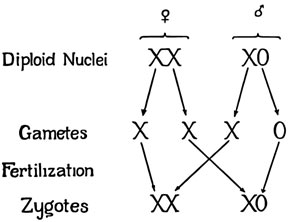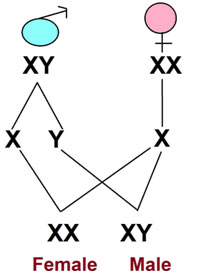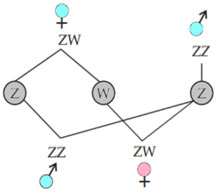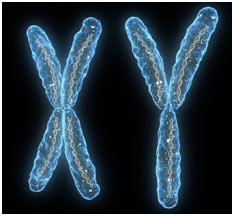Introduction
The chromosomes which determine the sex in different organisms are called sex chromosomes. This term refers to the process that enables species to exchange genetic material between homologous chromosomes.
This produces recombination which is necessary for reproduction and important genetic changes in next generations.
Mechanisms of Sex Determination
There are three mechanisms for sex determination of different organisms:
- XO Mechanism
- XY Mechanism
- ZW Mechanism
XO Mechanism
The sex-determining mechanism in which sex is determined by the X chromosome only is called the XO mechanism. Grasshoppers and protenor bugs follow this mechanism.
Let us the case example of protenor bug.
Male protenor bug:
Male protenor bug has 13 chromosomes in diploid cells. It has 6 pairs of autosomes but only one X chromosome. So, it is XO. The other sex chromosome is entirely missing. Thus, the male is heterogametic and produces two types of sperms.
Half of them have 6 pairs of autosomes and one X chromosome. While the other half have 6 pairs of autosomes and no sex chromosome. A gamete without any sex chromosome is called nullogamete.

Female protenor bug:
The female protenor bug has 14 chromosomes in diploid cells. The female has 6 pairs of autosomes and two X chromosomes. Thus, it is XX. It forms only one type of eggs. So, the female bug is homogametic.
The type of sperm determines the sex of offspring. If an X carrying sperm fertilizes the egg, a XX female offspring are produced. If the nullo sperm fertilizes the egg, an XO male offspring is produced. The sex ratio between male and female offsprings is 1:1.
XY Mechanism

The pattern which determines the sex by X and Y chromosomes is called the XY mechanism. This pattern is an exhibit by Humans, Drosophila, some snakes, fishes, etc.
Male:
The male is heterogametic as it contains XY. It produces two types of sex-determining sperms. Half the sperms carry X chromosomes and the other half carry Y chromosomes. Both types of sperms have equal chances to form.
Female:
Female is homogametic as it contains XX. It produces only one type of gamete. The egg has X chromosome.
In the XY mechanism, the sperm determines the sex of the offspring. If an X- carrying sperm fertilized the egg, the zygote will be XX and a female is produced. If a Y- carrying sperm fertilizes the egg, the zygote will be XY and a male offspring is produced.
Humans:
Humans have 23 pairs or 46 chromosomes. 22 pairs are of autosomes and one pair is of sex chromosome. Autosome pairs are common in both sexes. But the 23rd sex chromosome pair is different in males and females.
A male has X chromosome and a much shorter Y chromosome with the SRY gene. The 23rd pair in man is heteromorphic. While the female has both XX chromosomes.
Drosophila:
Drosophila also contains XY mechanism of sex determination. But here Y does not play much role as it does not have the SRY gene. In Drosophila, the X chromosome determines the female and the autosome determines the male.
WZ Mechanism
The ZW mechanism is common in birds, butterflies, and moths. This was discovered by J. Seiler in 1914 in the moth. It is the reverse of the XY system.

Female:
In this system, the female is heterogametic XY and produces two types of eggs X and Y in equal proportions.
Male:
The male is homogametic XX and each carries X chromosome so they all are similar.
The sex of offspring is determined by the egg. When X- carrying egg is fertilized by the sperm, a male offspring is produced. When sperm fertilizes the Y- carrying egg, female offspring are produced. The sex ratio between offsprings is 1:1.

